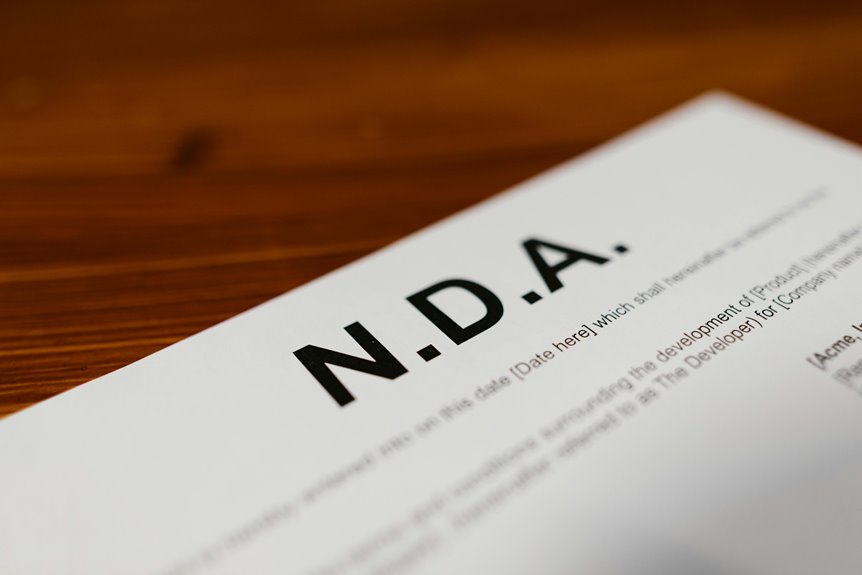Many freelancers overlook the importance of Non-Disclosure Agreements (NDAs), thinking they’re only for big corporations. However, safeguarding your ideas and strategies is essential in today’s competitive landscape. Knowing when and how to use an NDA can protect your creative work and build trust with clients. But what key elements should you include, and how do you handle situations when a client hesitates to sign? Understanding these aspects can make all the difference in your freelance career.
Table of Contents
Key Takeaways
- Use NDAs when discussing sensitive information like marketing strategies, product designs, or proprietary data with clients or collaborators.
- NDAs establish trust and protect both client confidentiality and freelancer creative ideas during projects.
- Clearly define confidential information, obligations, duration, and any exceptions within the NDA for clarity.
- NDAs are beneficial for freelancers of all sizes and not just large companies or high-profile projects.
- Negotiate terms to include permitted uses of information and consequences for breaches to ensure protection.
Understanding Non-Disclosure Agreements
When you work as a freelancer, understanding non-disclosure agreements (NDAs) is vital for protecting your ideas and client information. NDAs are legally binding contracts that prevent you from sharing sensitive information with others. They establish trust between you and your clients, guaranteeing that proprietary data remains confidential.
Familiarizing yourself with the key components of an NDA, such as the definition of confidential information, the duration of the agreement, and any exceptions, is important. You’ll want to make sure that the terms are clear and fair before signing.
When to Use an NDA as a Freelancer
Why should you consider using an NDA as a freelancer? An NDA protects your client’s sensitive information and your own creative ideas.
Use an NDA when you’re discussing proprietary information, like marketing strategies or product designs, especially in industries where confidentiality is vital. It’s also wise to implement one if you’re collaborating with other freelancers or contractors on a project.
If a client requests you to sign an NDA, it shows they value confidentiality, and you should take it seriously. Additionally, if you’re working on a long-term project that involves the development of unique concepts, an NDA can safeguard your intellectual property.
Ultimately, it fosters trust and professionalism in your freelance relationships.
Key Components of an NDA
Understanding the key components of an NDA is essential for freelancers who want to protect their interests. First, you need to clearly define what confidential information is covered. This includes any trade secrets, client lists, or project specifics.
Next, specify the obligations of the parties involved; both you and the other party should understand your responsibilities regarding the information.
Another important component is the duration of confidentiality. Decide how long the NDA will remain in effect, as it can vary based on the nature of the information.
Additionally, include any exclusions to confidentiality, such as information already in the public domain.
Finally, make certain that there are consequences for breaches, which will deter unauthorized sharing and hold parties accountable.
Common Myths About NDAs
Many freelancers fall prey to common myths about Non-Disclosure Agreements (NDAs), which can lead to misconceptions about their purpose and effectiveness.
One prevalent myth is that NDAs are only for large companies or high-profile projects. In reality, they’re useful for any freelancer wanting to protect sensitive information.
NDAs aren’t just for large companies; they’re essential for any freelancer aiming to safeguard sensitive information.
Another misconception is that NDAs are too complicated or unnecessary. In fact, they’re straightforward agreements that can safeguard your ideas and work.
Some believe signing an NDA will guarantee their ideas remain secret, but it’s important to remember that enforcement depends on legal frameworks.
Finally, many think NDAs are only for clients. However, you should also consider using them with collaborators and other freelancers to guarantee everyone’s on the same page.
How to Draft an Effective NDA
When it comes to protecting your sensitive information, knowing how to draft an effective NDA is key. Start by clearly defining what constitutes confidential information. Be specific to avoid ambiguity.
Next, outline the obligations of both parties, including how they should handle and protect the information. Set a reasonable time frame for confidentiality—typically one to five years is standard.
It’s crucial to include provisions for legal remedies in case of a breach. Also, consider adding non-compete and non-solicitation clauses if applicable.
Finally, make sure both parties sign and date the NDA to guarantee its enforceability. By following these steps, you’ll create a strong NDA that safeguards your interests and fosters trust with your clients.
Tips for Negotiating NDA Terms
When negotiating NDA terms, it’s vital to understand the essential elements that should be included to protect your interests.
Don’t forget that flexibility in the negotiation process can lead to a more favorable agreement for both parties.
Essential Terms to Include
As you prepare to negotiate the terms of your Non-Disclosure Agreement (NDA), it’s essential to include critical elements that protect your interests.
First, clearly define what constitutes confidential information. Specify the duration of the confidentiality obligation, ensuring it lasts long enough to safeguard your sensitive data.
Include the permitted uses of the information to prevent misuse. Also, outline the obligations of both parties regarding how they should handle the confidential information.
Don’t forget to address the consequences of any breach, which can deter violations.
Finally, consider adding a clause for dispute resolution to streamline any potential conflicts.
Flexibility in Negotiation Process
While negotiating NDA terms, it’s essential to remain adaptable and open to compromise. Start by identifying your must-haves and areas where you’re willing to be flexible. This approach not only strengthens your position but also fosters a cooperative atmosphere.
Ask questions to clarify the client’s needs and concerns; understanding their perspective can lead to mutually beneficial adjustments.
Don’t shy away from proposing alternatives if certain terms seem too restrictive. For example, if the duration feels excessive, suggest a shorter timeframe while emphasizing your commitment to confidentiality.
What to Do if a Client Refuses to Sign an NDA
If a client refuses to sign an NDA, it’s essential to assess your options carefully. Here are four steps you can take to protect yourself and your work:
- Clarify Their Concerns: Open a dialogue to understand why they’re hesitant. This can reveal their perspective and help find a compromise.
- Evaluate the Project: Consider the nature and sensitivity of the work. If it involves proprietary information, their refusal may be a red flag.
- Set Clear Boundaries: Communicate your expectations regarding confidentiality, even without a formal agreement.
- Decide on Your Comfort Level: Trust your instincts—if you’re uncomfortable moving forward without an NDA, it might be best to walk away. Your peace of mind is vital.
Enforcing an NDA: Your Rights and Options
When you’ve got a signed Non-Disclosure Agreement (NDA) in place, it’s essential to know your rights and options for enforcement.
If you believe someone has breached the NDA, your first step is to gather evidence of the violation. This could include emails, documents, or other communications that demonstrate the breach.
Next, consider reaching out to the offending party to discuss the issue. Sometimes, a simple conversation can resolve the matter without escalating it.
Consider a conversation with the offending party; it may resolve the issue without further complications.
If that doesn’t work, you may need to send a formal demand letter, outlining the breach and requesting compliance.
If all else fails, consult with a lawyer who specializes in contract law to explore the possibility of legal action to protect your rights and interests.
Frequently Asked Questions
Can I Use an NDA for Personal Projects?
Absolutely, you can use an NDA for personal projects. It helps protect your ideas and guarantees others involved keep your information confidential. Just make sure it’s clear, specific, and everyone involved understands their obligations.
Are Verbal NDAS Legally Binding?
Verbal NDAs can be legally binding, but they’re hard to enforce. You might struggle to prove what was agreed upon. It’s better to use written agreements for clarity and stronger legal protection.
How Long Should an NDA Last?
“Time flies when you’re having fun,” but an NDA typically lasts one to three years. You should consider the sensitivity of the information and your specific needs when determining the duration for your agreement.
What Happens if Someone Breaches an NDA?
If someone breaches an NDA, they can face legal consequences. You might need to take them to court, seek damages, or enforce the agreement. It’s essential to understand your options and protect your confidential information.
Can I Still Work With Competitors After Signing an NDA?
About 60% of freelancers juggle multiple clients simultaneously. If you’ve signed an NDA, you might face restrictions on working with competitors, so it’s essential to read the terms carefully before taking on new projects.




